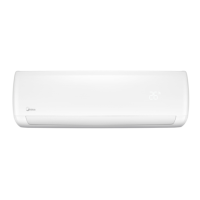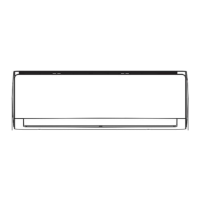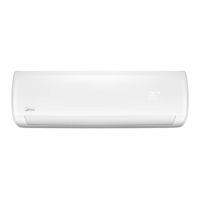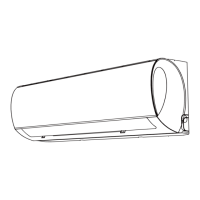
Do you have a question about the Midea MSMBCU-18HRFN1-QRD0GW and is the answer not in the manual?
| Brand | Midea |
|---|---|
| Model | MSMBCU-18HRFN1-QRD0GW |
| Category | Air Conditioner |
| Language | English |
To prevent injury to users and property damage, follow safety instructions carefully.
Lists critical warnings regarding installation, operation, and maintenance to prevent hazards.
Provides important cautions regarding refrigerant handling, installation, and operational safety.
Lists the model names for indoor and outdoor units based on their cooling capacity.
Details the physical dimensions (Width, Depth, Height) of various indoor unit models.
Illustrates recommended minimum installation clearances for the outdoor unit.
Illustrates the refrigerant flow within the indoor and outdoor units during cooling/heating cycles.
Provides precise torque specifications for connecting pipe fittings during installation.
Specifies cable cross-sectional areas based on the appliance's rated current.
Details standard and maximum pipe lengths, elevation limits, and refrigerant amounts per model.
Guides through the initial installation process, including leak testing and system evacuation.
Explains the procedure for adding refrigerant to a system that has been in use for years.
Outlines steps for collecting refrigerant and re-installing the indoor unit post-repair.
Details evacuation and refrigerant charging for re-installing the outdoor unit.
Defines the optimal operating temperature ranges for cooling, heating, and drying modes.
Lists abbreviations for key temperature sensors and operational parameters (T1-T5).
Explains the digital display and icons on the indoor unit, including status indicators.
Describes various internal protection mechanisms and their triggering conditions.
Details operational modes (Fan, Cooling, Auto) and associated fan/compressor running rules.
Emphasizes safety precautions, particularly discharging electricity from capacitors before checks.
Lists error codes displayed on the indoor unit and their corresponding LED status indicators.
Provides diagnosis and solutions for EEPROM parameter errors (E0/F4).
Offers troubleshooting steps for communication errors between indoor and outdoor units (E1).
Details troubleshooting procedures for fan speed control malfunctions (E3/F5).
Guides on diagnosing and solving refrigerant leakage detection errors (EC).
Provides troubleshooting for open/short circuits in various temperature sensors (E4/E5/F1/F2/F3).
Offers solutions for IPM malfunction or IGBT over-strong current protection errors (P0).
Details troubleshooting for over/under voltage protection issues detected in the unit (P1).
Guides on diagnosing and resolving high temperature protection errors for the compressor top (P2).
Provides troubleshooting steps for abnormal inverter compressor drive errors (P4).
Explains how to check temperature sensors by measuring their resistance values with a tester.
Details how to check compressor windings by measuring resistance values of each winding.











